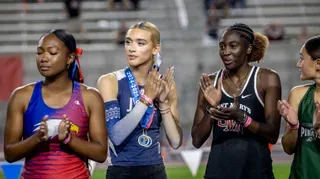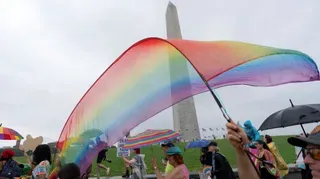February 14, 2011
In Time for St. Valentine's Day: Census Data Suggests Marriage Acceptance Brings Gay Families Out of the Closet
Kilian Melloy READ TIME: 3 MIN.
It's been known as anecdotally true for some time that the greater the visibility of GLBT individuals, the greater their acceptance in society at large--and thus, in a virtuous circle, the greater the visibility of GLBT individuals.
The latest Census data now indicates that the same is also true of gay and lesbian families. A Feb. 8 Boston Globe article detailed how more same-sex families in Massachusetts--and around the nation--are willing to disclose their relationship status.
Though the Census did not ask about same-sex relationships or marital status directly, researchers are able to estimate the number of the state's same-sex families reporting on their status by cross-referencing responses to several queries.
The 2010 Census reflected a 17% rise in the number of same-sex families willing to give data that showed their relationship status. as compared to the 2000 Census, the Globe article said. Marriage equality has been legal in Massachusetts for seven years, with the first gay and lesbian couples marrying legally in May of 2004. The article said that the new data suggested to GLBT equality advocates that allowing same-sex couples marriage parity provides social equality as well, and creates a sense of safety in being open.
"As it becomes safer to come out, people come out," said the head of MassEquality, Kara Suffredini.
Another major shift: same-sex families in cities seen as "gay friendly" used to be more likely to disclose their relationship status. Now, a much broader pattern of residence can be seen, with gay and lesbian families living all across the state. "The joke used to be that we all live in gay ghettos," the Massachusetts Gay & Lesbian Political Caucus' Arline Isaacson told the Boston Globe. "But you can't make that joke any more. They have expanded significantly in the suburbs."
The advent of marriage equality has given some families a sense that they need to be out of the closet for the good of their community. Census data is used to determine where funding goes, and what sorts of programs in any given city or region get prioritized.
"The government needs to know we're here, and we're strong in numbers," Karin Blake 68, the wife of Connie Tassinari, told the Globe. "We exist, and we're always going to be here."
The article noted that even more stark rises in the number of gay and lesbian couples willing to report on their relationships were noted in other parts of the country, particularly conservative and rural areas. Only five states currently allow same-sex families to marry, but that handful of states may have helped create a national climate that is far more accepting than was once the case.
A similar pattern emerged in Canada after the 2006 census there. Same-sex marriage became a matter of national law in Canada in 2005; by the time of the following year's census, a striking increase in the number of gay and lesbian families willing to self-disclose was already evident, reported the Edmonton Journal on Sept. 13, 2007.
The results of the 2006 census showed an increase of nearly one-third more same-sex families than the previous Canadian census, in 2001, had indicated. "The growth cannot be solely explained by population growth over the last five years," said demographics expert Laurent Martel.
When Canada conducts its next census this year, experts anticipate seeing another sharp increase in the number of same-sex families who declare themselves to the government. A similar two-part increase was seen when the census began to track common-law relationships in the early 1980s: It took two rounds of the census (ten years) for reluctance and stigma to fall away and a truer picture to emerge of the actual numbers.
Kilian Melloy serves as EDGE Media Network's Associate Arts Editor and Staff Contributor. His professional memberships include the National Lesbian & Gay Journalists Association, the Boston Online Film Critics Association, The Gay and Lesbian Entertainment Critics Association, and the Boston Theater Critics Association's Elliot Norton Awards Committee.




